Geostatistical Methodology to Characterize Volcanogenic Massive and Stockwork Ore Deposits
Abstract
:1. Introduction
2. Materials and Methods
2.1. Geological Background
2.2. Methodology
- Build a low-resolution 3D morphological model, delimiting the external boundaries and the main transition between massive ores in the top (RM) and stockwork ores in the bottom (RS). For the construction of this solid model, a classical procedure is used which involves digitalization of closed polygons in several almost parallel cross-sections, interpolation of surfaces, merger of surfaces in order to build a closed volume, and conversion of the volume into a voxel model (grid mining blocks).
- Taking into account the paragenesis of the Zambujal deposit, evaluate empirical cdf(s) of the random variable P(x) at boreholes locations conditional to the SG, grades of metals and sulfur grade all obtained from lab measurements to boreholes samples.
- 3.
- For estimation plus simulation of ns1 scenarios of this variable, generate ns1 scenarios of P(x) for each borehole sample and compute their average. The Probability Field Simulation (PFS) algorithm [32] is used to draw values from the local cdf(s), instead of Monte Carlo simulation, as it accomplishes with both the local cdf(s) and the spatial continuity model of P(x).
- 4.
- Compute the auxiliary variable relative copper grade YCu(x) at sample locations. By using the values generated in step 3, ns1 scenarios of YCu(x) plus the average scenario are obtained.
- 5.
- Estimate regional cdf(s) of the studied random variables P(x), YCu(x) and SG(x) for both regions RM and RS by Indicator Kriging (IK) and estimate average images of those variables by Ordinary Kriging (OK) [33].
- 6.
- Build a high-resolution morphological model of P(x) only within the blocks of each region RM or RS, with Direct Sequential Simulation (DSS) conditional to the cdf(s) per ore type region [34].
- 7.
- Similarly to P(x), simulate the relative grade of Cu YCu(x) by using DSS conditional to cdf(s) per ore type region [34]; ns = ns1·ns2 realizations are simulated, ns2 for each one of ns1 realizations of P(x).
- 8.
- 9.
- Evaluate uncertainty, computing local variance of the simulated values for P(x) and YCu(x).
- 10.
- Build a parametric global surface of copper metal tonnages and function of cut-off copper grades in massive ores and in stockwork ores.
- (1)
- Variables P(x), and are not stationary within the Zambujal deposit but are rather constrained to ore types. For this reason, it was essential to delimit RM and RS bodies with 3D computer solids and to constrain the simulations to the regional cdf(s) of the studied variables per RM or RS ore type. A modified version of DSS in which the simulated values are resampled from the regional cdf(s) is used to simulate the entire deposit [34] (steps 6 and 7 of the methodology).
- (2)
- The boreholes assays are made mostly at one meter length and the block size is 2 m × 2 m × 2 m (this is the size of the mining blocks used by the mining company, since it is considered the most suitable for stope design and mine planning). In order to make these scales compatible, prior to the application of the OK and DSS, the values of the boreholes are transferred to the blocks of the model that contained them, and when there are several samples in each block the arithmetic mean is made.
3. Case Study and Results
3.1. Low Resolution 3D Morphological Model
3.2. Evaluate the Empirical Cdf of the Random Variable P(x) at Boreholes Locations
3.3. Estimation and Simulation of P(x), ZCu(x)and YCu(x) Variables
3.4. Construction of the Tonnage-Surface Function for Copper Grades and Geological Dilution
4. Discussion and Conclusions
- The proportion between sulfides and host rock P(x) can be modeled as a morphological random variable. Local values of P(x) at the borehole locations allow calculating the auxiliary variable relative copper grades YCu(x), meaning the hypothetical metal grades if host rock is not considered.
- Modeling the relative copper grades variable YCu(x) together with the proportion variable P(x), adds information to each mine block and enables the establishment of conditional cut-off grades to grades and morphology.
Acknowledgments
Author Contributions
Conflicts of Interest
References
- Rossi, M.E.; Deutsch, C.V. Mineral Resource Estimation; Springer: London, UK, 2014; p. 332. [Google Scholar]
- Almeida, J.A.; Soares, A.; Reynaud, R. Modelling the Shape of Several Marble Types in a Quarry. In Proceedings of the 24th International Symposium on Computer Applications in the Minerals Industries (APCOM), Montreal, QC, Canada, 31 October–2 November 1993; Elbrond, J., Tang, X., Eds.; Canadian Institute of Mining, Metallurgy and Petroleum: Montreal, QC, Canada, 1993; Volume 3, pp. 452–459. [Google Scholar]
- Castañón, C.; Arias, D.; Diego, I.; Martin-Izard, A.; Ruiz, Y. Resource and Reserve Calculation in Seam-Shaped Mineral Deposits; A New Approach: “The Pentahedral Method”. Minerals 2017, 7, 72. [Google Scholar] [CrossRef]
- Caers, J. Modeling Uncertainty in the Earth Sciences; Wiley-Blackwell, John Wiley & Sons Ltd.: London, UK, 2011. [Google Scholar]
- Mortensen, M.E. Geometric Modeling; John Wiley & Sons Inc.: New York, NY, USA, 1985. [Google Scholar]
- Cowan, E.J.; Beatson, R.K.; Ross, H.J.; Fright, W.R.; Mclennan, T.J.; Evans, T.R.; Carr, J.C.; Lane, R.G.; Bright, D.V.; Gillman, A.J.; et al. Practical implicit geological modelling. In Proceedings of the 5th International Mining Geology Conference, Bendigo, Australia, 17–19 November 2003; Dominy, S., Ed.; Australian Institute of Mining and Metalurgy: Carlton, Australia, 2003; pp. 89–99. [Google Scholar]
- Vollgger, S.A.; Crudena, A.R.; Ailleres, L.; Cowan, E.J. Regional dome evolution and its control on ore-grade distribution: Insights from 3D implicit modelling of the Navachab gold deposit, Namibia. Ore Geol. Rev. 2015, 69, 268–284. [Google Scholar] [CrossRef]
- Armstrong, M.; Galli, A.; Beucher, H.; Le-Loc’h, G.; Renard, D.; Doligez, B.; Eschard, R.; Geffroy, F. Plurigaussian Simulations in Geosciences; Springer: Berlin, Germany, 2011. [Google Scholar]
- Talebi, H.; Asghari, O.; Emery, X. Stochastic rock type modeling in a porphyry copper deposit and its application to copper grade evaluation. J. Geochem. Explor. 2015, 157, 162–168. [Google Scholar] [CrossRef]
- Goovaerts, P. Geostatistics for Natural Resources Evaluation; Oxford University Press: New York, NY, USA, 1997. [Google Scholar]
- Isaaks, E.H.; Srivastava, R.M. An Introduction to Applied Geostatistics; Oxford University Press: New York, NY, USA, 1989. [Google Scholar]
- Almeida, J.A. Stochastic simulation methods for characterization of lithoclasses in carbonate reservoirs. Earth-Sci. Rev. 2010, 101, 250–270. [Google Scholar] [CrossRef]
- Deutsch, C.V.; Journel, A.G. GSLIB: Geostatistical Software Library and User’s Guide; Oxford University Press: New York, NY, USA, 1998; p. 384. [Google Scholar]
- Almeida, J. Modelling of cement raw material compositional indices with direct sequential cosimulation. Eng. Geol. 2010, 114, 26–33. [Google Scholar] [CrossRef]
- Chiles, J.P.; Delfiner, P. Geostatistics: Modeling Spatial Uncertainty; Wiley: New York, NY, USA, 1999. [Google Scholar]
- Quental, P.; Almeida, J.A.; Simões, M. Construction of high-resolution stochastic geological models and optimal upscaling to a simplified layer-type hydrogeological model. Adv. Water Resour. 2012, 39, 18–32. [Google Scholar] [CrossRef]
- Charifo, G.; Almeida, J.A.; Ferreira, A. Managing borehole samples of unequal lengths to construct a high-resolution mining model of mineral grades zoned by geological units. J. Geochem. Explor. 2013, 132, 209–223. [Google Scholar] [CrossRef]
- Matias, F.; Almeida, J.; Chichorro, M. A multistep methodology for building a stochastic model of gold grades in the disseminated and complex deposit of Casas Novas in Alentejo, Southern Portugal. Resour. Geol. 2015, 65, 361–374. [Google Scholar] [CrossRef]
- Rosa, C.; McPhie, J.; Relvas, J.M.R.S.; Pereira, Z.; Oliveira, T.; Pacheco, N. Facies analyses and volcanic setting of the giant Neves Corvo massive sulfide deposit, Iberian Pyrite Belt, Portugal. Miner. Depos. 2008, 43, 449–466. [Google Scholar] [CrossRef]
- Jensen, M.L.; Bateman, A.M. Economic Mineral Deposits; John Wiley and Sons: New York, NY, USA, 1981; p. 593. [Google Scholar]
- Gerson, A.; Napier, T. Integrated Approaches for the Study of Real Mineral Flotation Systems. Minerals 2013, 3, 1–15. [Google Scholar] [CrossRef]
- Soares, A. Direct Sequential Simulation and Cosimulation. Math. Geosci. 2001, 33, 911–926. [Google Scholar]
- Nunes, R.; Almeida, J.A. Parallelization of sequential Gaussian, indicator and direct simulation algorithms. Comput. Geosci. 2010, 36, 1042–1052. [Google Scholar] [CrossRef]
- Tornos, F. Environment of formation and styles of volcanogenic massive sulfides: The Iberian Pyrite Belt. Ore Geol. Rev. 2006, 28, 259–307. [Google Scholar] [CrossRef]
- Gaspar, O.C. Paragenesis of the Neves-Corvo volcanogenic massive sulphides. Comunicações Serviços Geológicos Port. 1991, 77, 27–52. [Google Scholar]
- Barriga, F.J.; Carvalho, D.; Ribeiro, A. Introduction to the Iberian Pyrite Belt. In Geology and VMS Deposits of the Iberian Pyrite Belt; Neves Corvo Field Conference; Guidebook Series; Barriga, F.J., Carvalho, D., Eds.; Society of Economic Geologists: Lisbon, Portugal, 1997; Volume 27. [Google Scholar]
- Relvas, J.; Barriga, F.; Pinto, A.; Ferreira, A.; Pacheco, N.; Noiva, P.; Barriga, G.; Baptista, R.; Carvalho, D.; Oliveira, V.; et al. The Neves-Corvo Deposit, Iberian Pyrite Belt, Portugal: Impacts and Future 25 years after the Discovery. In Integrated Methods for Discovery: Global Exploration in 21st Century, Society of Economic Geologists Special Pub; Goldfarb, R., Nielsen, J., Eds.; Society of Economic Geologists: Littleton, CO, USA, 2002; Volume 9, pp. 155–176. [Google Scholar]
- Silva, D. Modelação Estocástica do Depósito Mineral do Zambujal (Mina de Neves-Corvo): Contribuição da Densidade como Indicador Morfológico. Master’s Thesis, FCT—Nova University of Lisbon, Monte da Caparica, Portugal, 2015. (In Portuguese). [Google Scholar]
- Almeida, J.A.; Soares, A.; Mariano, A.C.; Albuquerque, A. Zonal control of reserves estimation of a diamond alluvial deposit. In Proceedings of the Conference on Mining Geostatistics, Berg-en-dal, Kruger National Park, South Africa, 19–22 September 1994; Geostatistical Association South Africa: Berg-en-dal, Kruger National Park, South Africa, 1994; pp. 159–167. [Google Scholar]
- Almeida, J.A.; Soares, A.; Albuquerque, A. Zonal control to estimate classes of histograms: Application to a diamond alluvial deposit. In Geostatistics Wollongong ’96; Baafi, E.Y., Schofield, N.A., Eds.; Kluwer Academic Publishers: Dordrecht, The Netherlands, 1996; pp. 658–668. [Google Scholar]
- Gower, J.C. A general coefficient of similarity and some of its properties. Biometrics 1971, 27, 857–871. [Google Scholar] [CrossRef]
- Froidevaux, R. Probability field simulation. In Geostatistics Troia 1992; Soares, A., Ed.; Kluwer Academic Publishers: Dordrecht, The Netherlands, 1993; pp. 73–84. [Google Scholar]
- Soares, A.; Tavora, J.; Pinheiro, L.; Freitas, C.; Almeida, J. Predicting Probability Maps of Air Pollution Concentration: A Case Study on Barreiro/Seixal Industrial Area. In Geostatistics Troia 1992; Soares, A., Ed.; Kluwer Academic Publishers: Dordrecht, The Netherlands, 1993; pp. 625–636. [Google Scholar]
- Roxo, S.; Almeida, J.A.; Matias, F.V.; Mata-Lima, H.; Barbosa, S. The use of sensory perception indicators for improving the characterization and modelling of total petroleum hydrocarbon (TPH) grade in soils. Environ. Monit. Assess. 2016, 188, 1–19. [Google Scholar] [CrossRef] [PubMed]
- Gerst, M.D. Revisiting the cumulative grade-tonnage relationship for major copper ore types. Econ. Geol. 2008, 103, 615–628. [Google Scholar] [CrossRef]
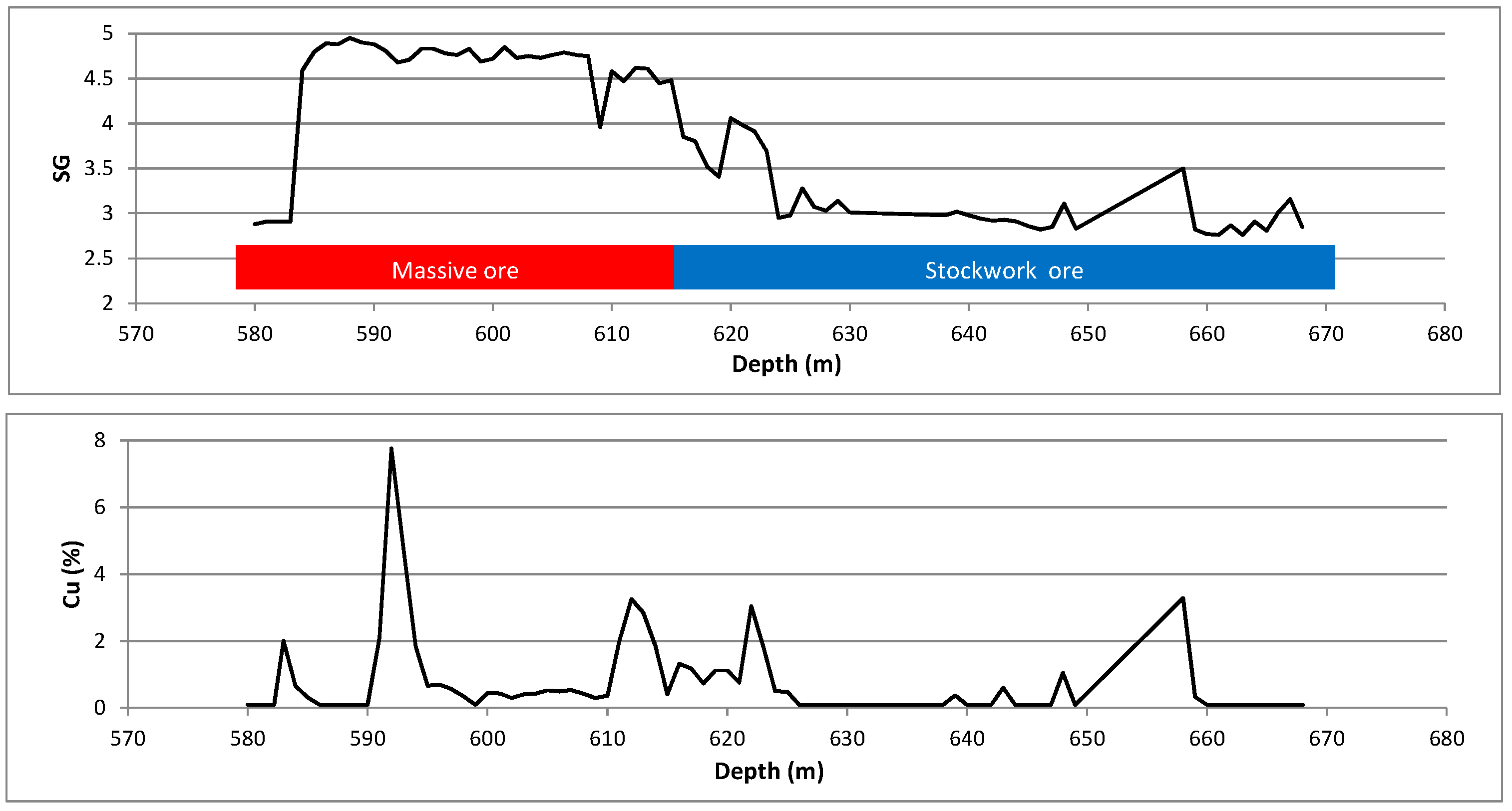
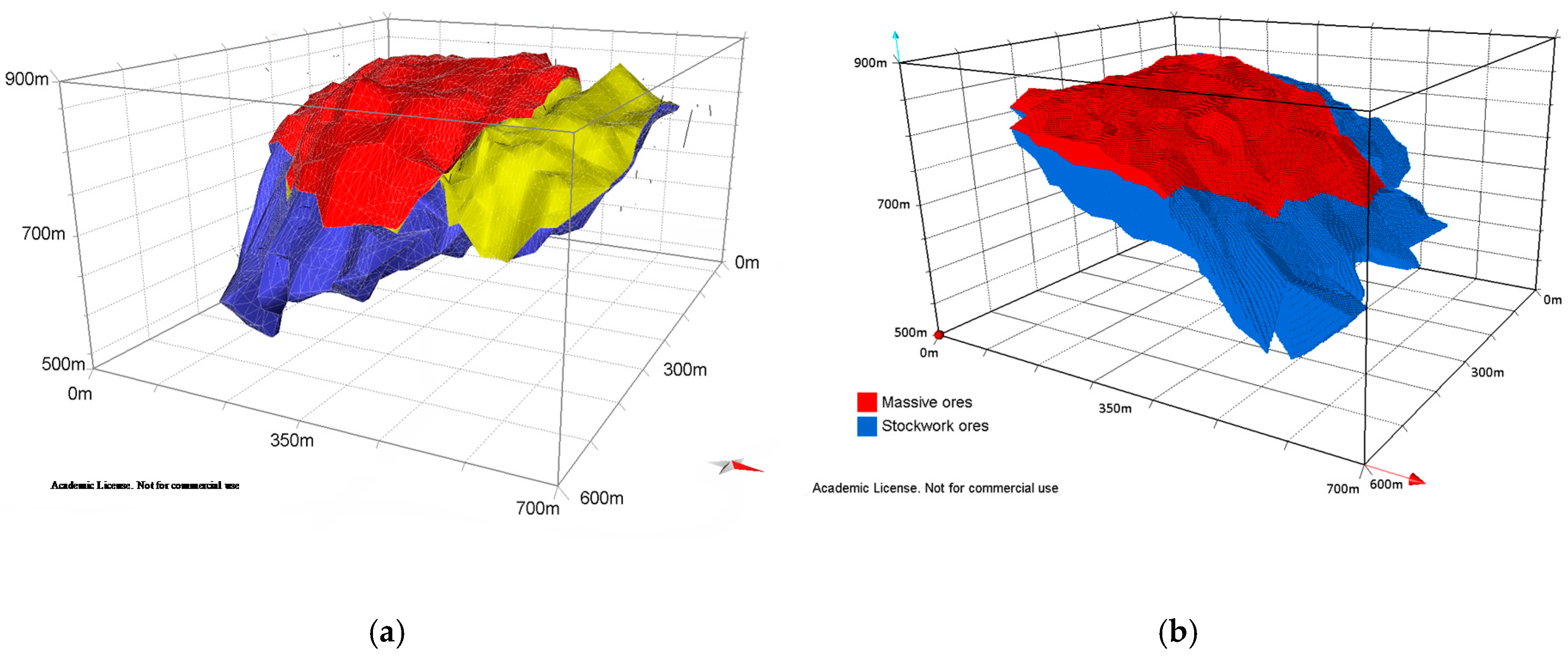
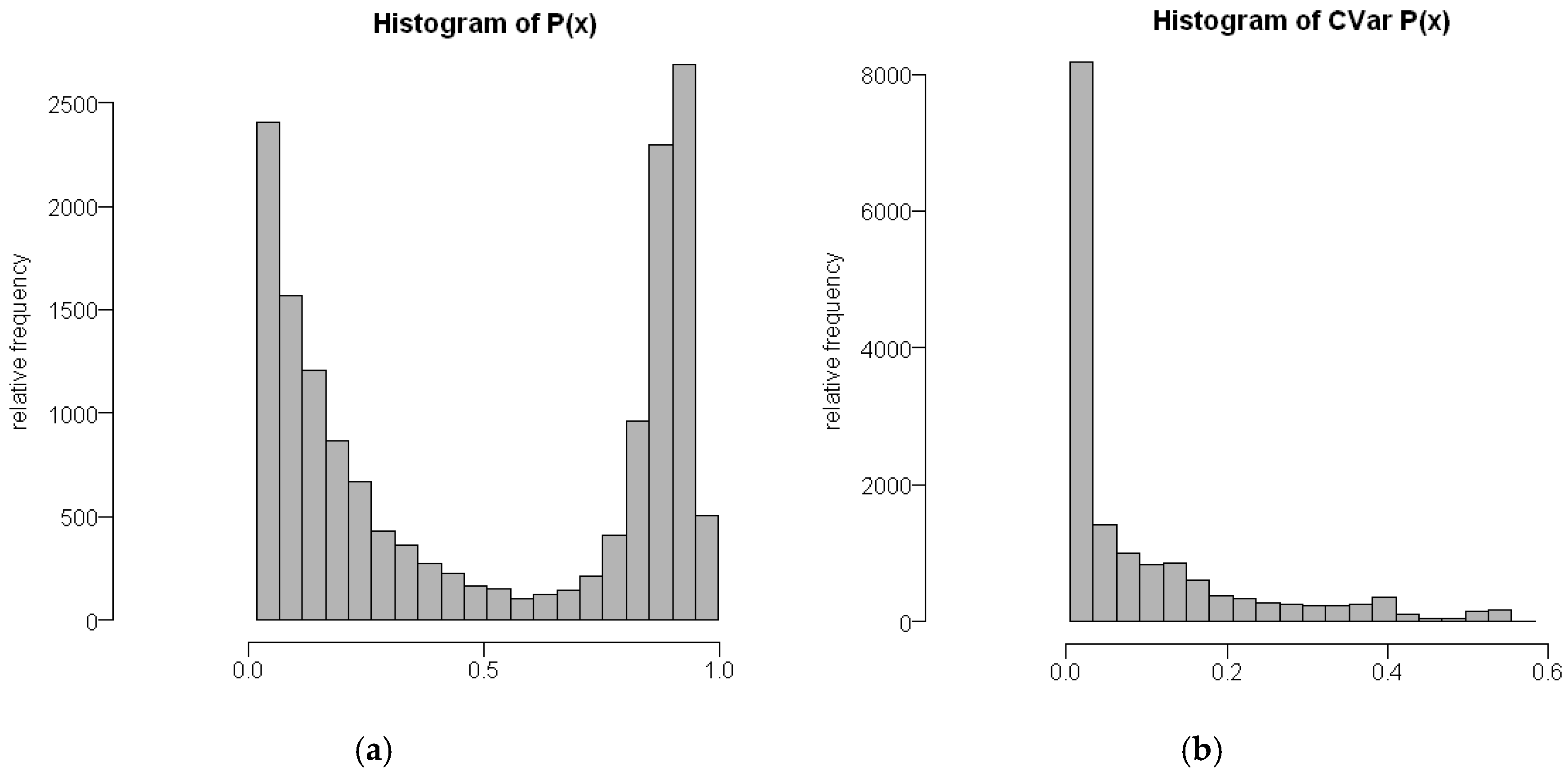


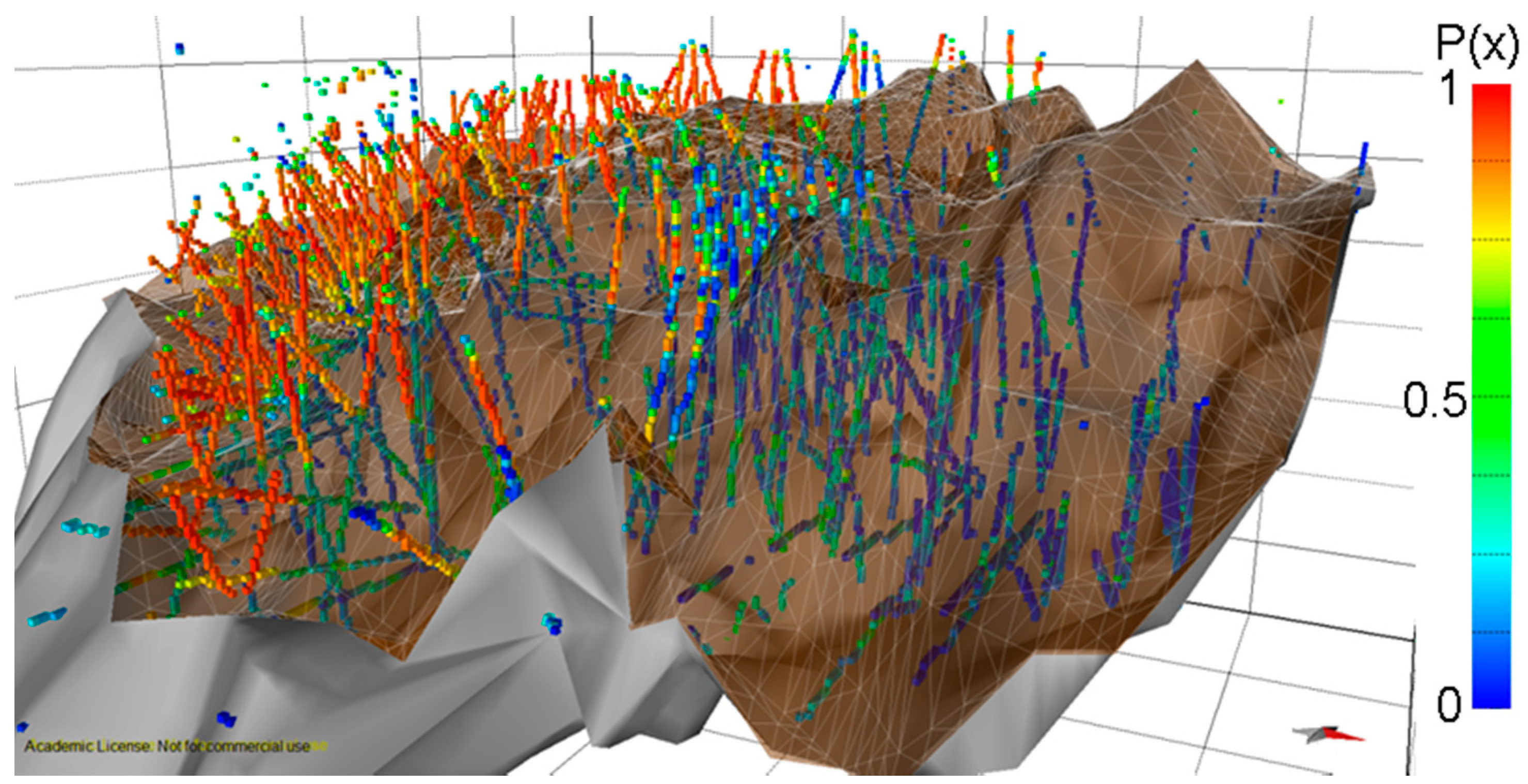
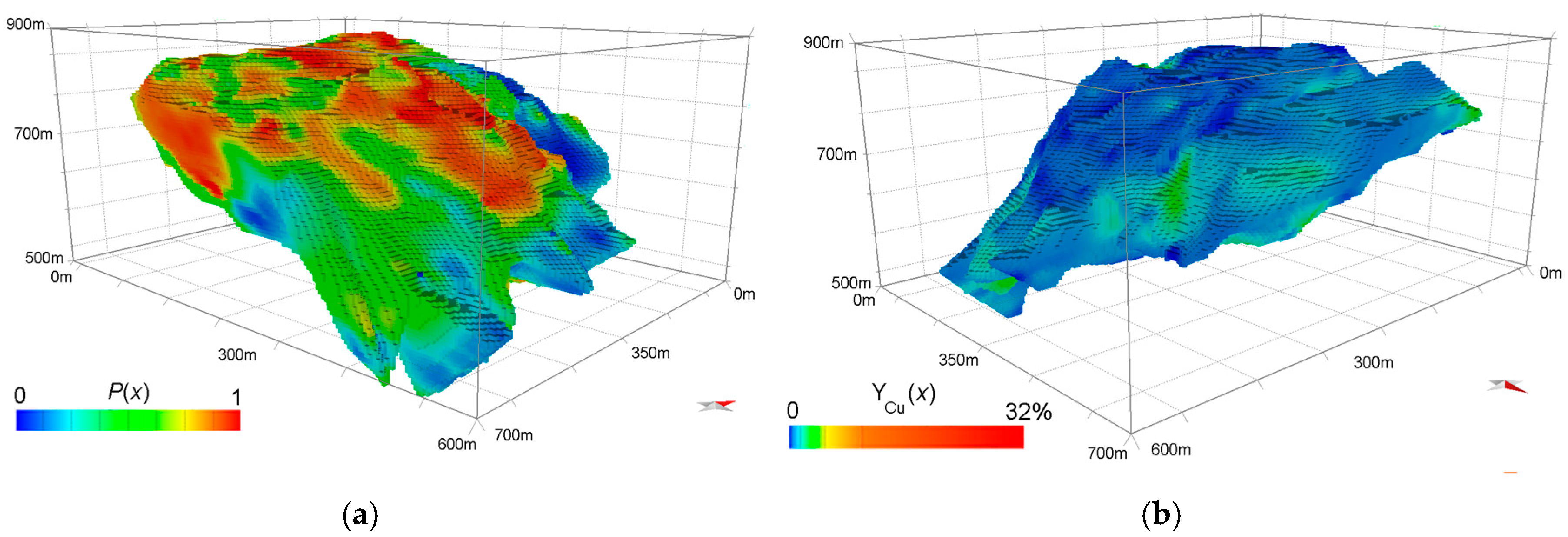
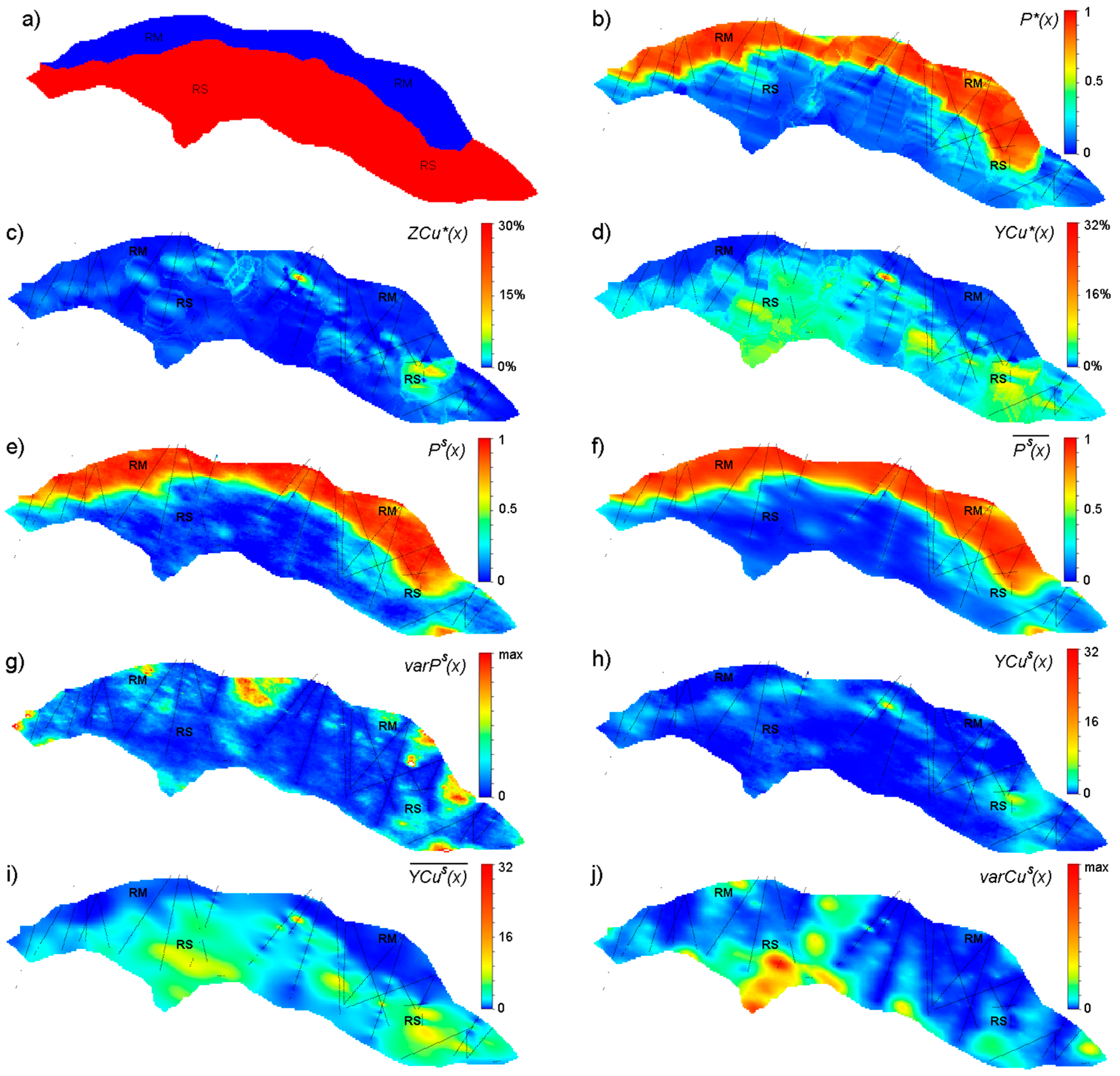

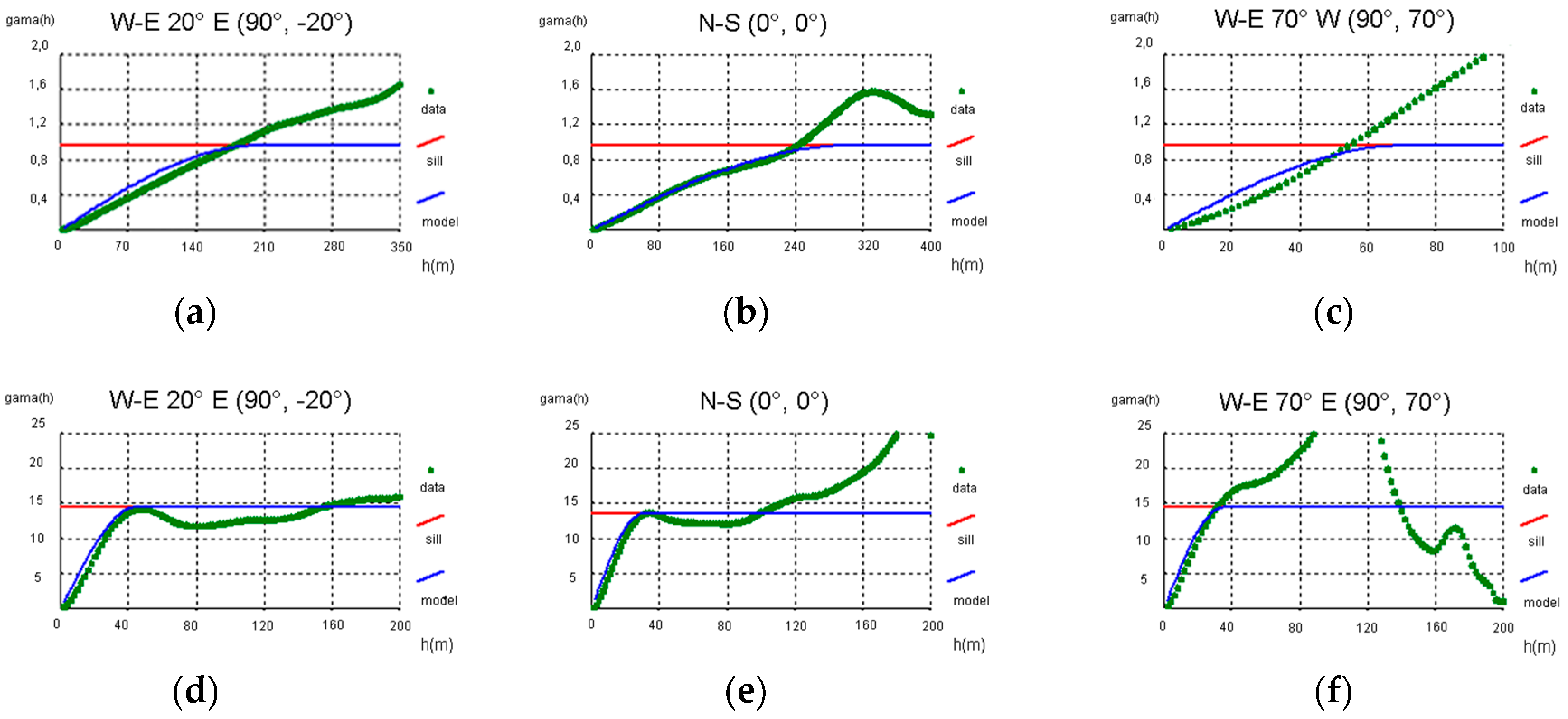
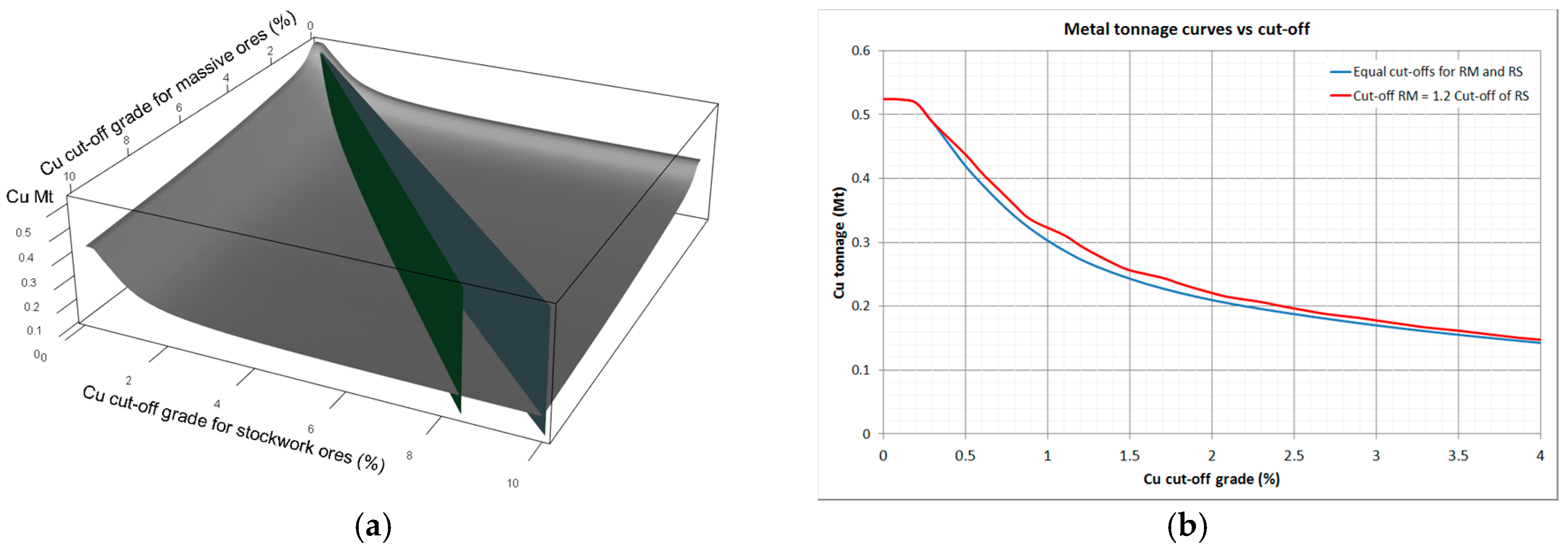
| Minerals/Rock | Formulas | SG | Fe (%) | S (%) | Cu (%) | Zn (%) | Pb (%) |
|---|---|---|---|---|---|---|---|
| Pyrite | FeS2 | 5.02 | 47 | 53 | |||
| Chalcopyrite | CuFeS2 | 4.20 | 30 | 35 | 35 | ||
| Sphalerite | ZnS | 4.00 | 33 | 67 | |||
| Galena | PbS | 7.50 | 13 | 87 | |||
| Host rock | 2.80 |
| Mixtures of Host Rock (HR) and Minerals (%) | Calculated Values of Grades (%) | SG’ | P’(x) | ||||||||
|---|---|---|---|---|---|---|---|---|---|---|---|
| HR | FeS2 | CuFeS2 | ZnS | PbS | Cu’ | Pb’ | Zn’ | S’ | Fe’ | ||
| 0 | 0 | 0 | 0 | 100 | 0 | 86.6 | 0 | 13.4 | 0 | 7.5 | 100 |
| 0 | 20 | 10 | 50 | 20 | 3.64 | 17.32 | 33.55 | 33.32 | 12.34 | 4.924 | 100 |
| 20 | 10 | 20 | 30 | 20 | 7.28 | 17.32 | 20.13 | 24.88 | 10.73 | 4.582 | 80 |
| 20 | 10 | 50 | 20 | 0 | 18.2 | 0 | 13.42 | 29.38 | 19.85 | 3.942 | 80 |
| 30 | 10 | 30 | 30 | 0 | 10.92 | 0 | 20.13 | 25.69 | 13.77 | 3.772 | 70 |
| 40 | 40 | 0 | 10 | 10 | 0 | 8.66 | 6.71 | 26.03 | 18.6 | 4.238 | 60 |
| 50 | 20 | 10 | 10 | 10 | 3.64 | 8.66 | 6.71 | 18.82 | 12.34 | 3.924 | 50 |
| 100 | 0 | 0 | 0 | 0 | 0 | 0 | 0 | 0 | 0 | 2.7 | 0 |
| Variable | Item | RM | RF | RM + RF |
|---|---|---|---|---|
| 3D solid model | Number of blocks | 737,049 | 1,802,404 | 2,539,453 |
| Ore volume (m3) | 5,896,392 | 14,419,232 | 20,315,624 | |
| [SG(x)]OK | 4.394 | 3.125 | 3.497 | |
| Ore tonnage (tons) | 25,908,746 | 45,060,100 | 70,968,846 | |
| Morphological model of P(x) | [P(x)]OK | 0.756 | 0.184 | 0.350 |
| VAR[P(x)]OK | 1.18 × 10−6 | 1.42 | 0.097 | |
| [P(x)]DSS | 0.768 | 0.176 | 0.348 | |
| VAR[P(x)]DSS | 1.08 × 10−6 | 2.05 × 10−7 | 0.099 | |
| Copper metal grades ZCu(x) and copper relative grades YCu(x) | [ZCu(x)]OK | 1.050 | 0.549 | 0.695 |
| VAR[ZCu(x)]OK | 2.44 × 10−6 | 3.71 × 10−7 | 1.740 | |
| [YCu(x)]OK | 1.465 | 3.289 | 2,763 | |
| [YCu(x)]DSS | 1.482 | 3.339 | 2.795 | |
| [YCu(x)]OK·[P(x)] OK | 1.051 | 0.545 | 0.692 | |
| VAR[YCu(x)]OK·[P(x)] OK | 1.92 × 10−6 | 3.25 × 10−7 | 1.629 |
© 2017 by the authors. Licensee MDPI, Basel, Switzerland. This article is an open access article distributed under the terms and conditions of the Creative Commons Attribution (CC BY) license (http://creativecommons.org/licenses/by/4.0/).
Share and Cite
Silva, D.; Almeida, J. Geostatistical Methodology to Characterize Volcanogenic Massive and Stockwork Ore Deposits. Minerals 2017, 7, 238. https://doi.org/10.3390/min7120238
Silva D, Almeida J. Geostatistical Methodology to Characterize Volcanogenic Massive and Stockwork Ore Deposits. Minerals. 2017; 7(12):238. https://doi.org/10.3390/min7120238
Chicago/Turabian StyleSilva, David, and José Almeida. 2017. "Geostatistical Methodology to Characterize Volcanogenic Massive and Stockwork Ore Deposits" Minerals 7, no. 12: 238. https://doi.org/10.3390/min7120238





